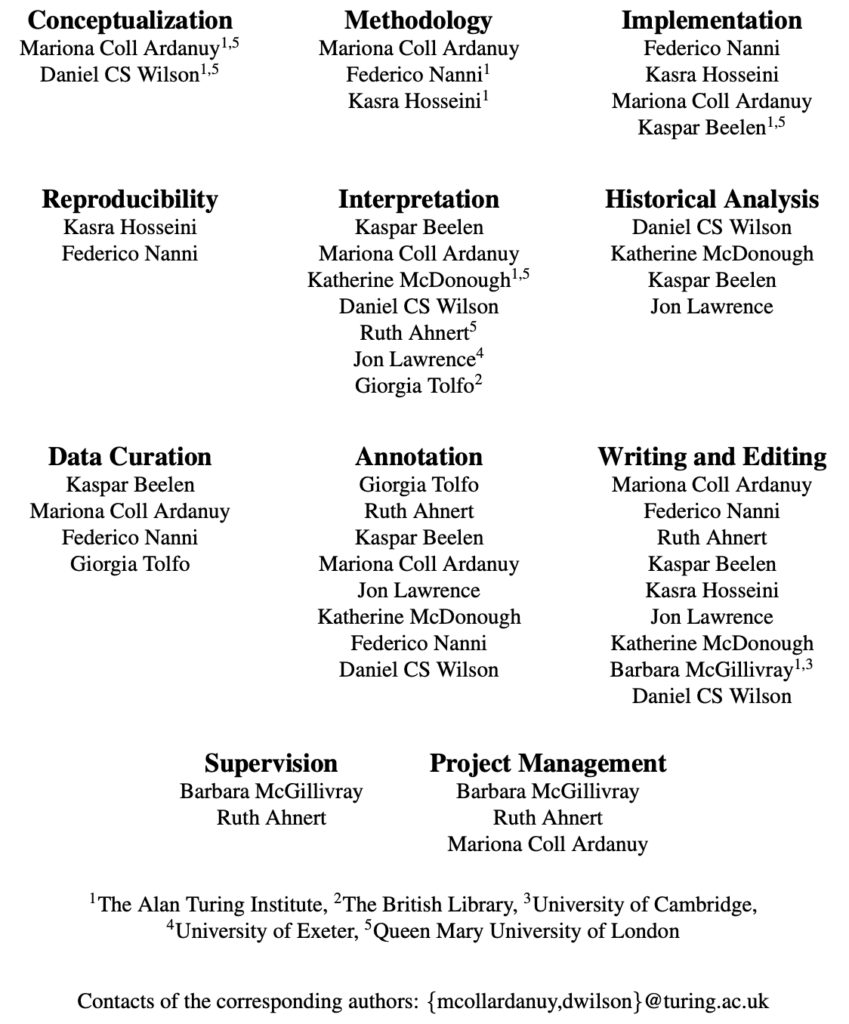Highlighting Authors’ Contributions and Interdisciplinary Collaborations in Living with Machines
We have recently uploaded a new paper to arXiv, an open-access repository of academic preprints. In that article, we examine the notion of atypical animacy in nineteenth-century books published in Britain. Particularly, we focus on scenarios in which typically inanimate, lifeless objects (specifically machines) are represented as living entities.
This is a methods paper, written through the lens of natural language processing, but is nevertheless the fruit of a collaboration among historians, literary scholars, digital humanists, data scientists, and computational linguists. In order to emphasise the highly interdisciplinary context in which this idea has been conceived and executed, we decided to introduce our paper with a cover-page that presents each author’s contributions to the work.

This is inspired by the current debate on the importance of recognising researchers’ contributions to a project and the necessity of offering alternatives for moving away from the inherent issues of deciding an author list (these have been the focus of papers, blog posts, tweets and comic strips). We have employed the CRediT Taxonomy, for which we have built a ‘film-credit’ cover page, inspired by previous discussions on this type of contribution overview (see especially the original post and idea by Steven Burgess and this following reflection by Devang Mehta).
An important advantage is that it highlights the many interdisciplinary interactions that are usually hidden behind the “academic curtain” and emphasises how many people are in fact contributing in ways that surpass their normal disciplinary roles. The roles below therefore complicate and enhance what might be inferred from the traditional list of disciplinary and institutional communities next to a person’s name. In using these roles, we signal specific interdisciplinary actions that might otherwise be invisible. Following the core spirit of the Living with Machines project, based upon radical collaboration and favouring practices that often challenge prevailing academic research traditions, our cover page presents:
- Eleven contribution roles, adapted from the original CRediT taxonomy model:
- Conceptualisation: Generates ideas; formulates or otherwise helps with evolution of overarching research goals and aims.
- Methodology: Develops or designs methodology; creates models.
- Implementation: Contributes to programming and software development; designs computer programs; implements computer code and supporting algorithms; tests existing code components.
- Reproducibility: Enables verification, whether as a part of the specific publication or as part the overall replication/reproducibility of results/experiments and other research outputs in the broader project.
- Interpretation: Applies statistical, mathematical, computational, or other formal techniques to analyse or synthesise study data.
- Historical Analysis: Uses methods of historical interpretation to analyse results.
- Data Curation: Scrubs and maintains research data (including software code, where it is necessary for interpreting the data itself) for initial use and later re-use.
- Annotation: Manages activities related to the production of annotations, including the production of guidelines, quality checking and the annotation process itself.
- Writing and Editing: Prepares, creates and/or presents the published work, including writing the initial draft, critical review, and (depending on the disciplinary venue) commentary or revision (including pre- or post-publication stages).
- Supervision: Oversees and leads research activity planning and execution, including mentors external to the core team.
- Project Management: Manages and coordinates research activity planning and execution.
- For each type of contribution, we have a lead person who coordinated this particular work strand and will be able to answer specific questions regarding, for example, annotations (Giorgia) or model interpretation (Kaspar). The remaining names are roughly sorted by the “amount” of contribution and, if equal, alphabetically.
- Two corresponding authors, Mariona and Daniel, who have led the work on the two main areas: Natural Language Processing and History. They are the main points of contact for anyone who would like to know more about this study.
It is important to remark that the success of this process especially relies on all authors openly acknowledging the importance of everyone’s contributions. We plan to further experiment with this model, especially in order to harmonise future projects as they unfold and to find new ways to give value to individual contributions. We are also discussing how to address potential drawbacks, from the apparent lack of flexibility when such structure is set to the fact that this model may give too much managing responsibility to the corresponding authors.
If you are interested in knowing more about our experience and on our next steps in this direction, get in touch either with Federico or Mariona. Or if you would like to accompany your paper with a film-credit cover page, Kasra has prepared a simple Overleaf template – enjoy!
